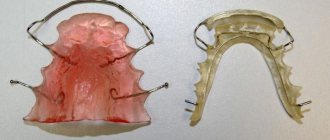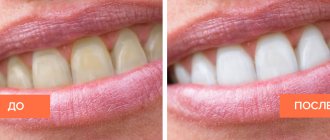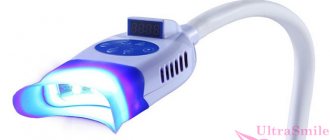Although whitening is a cosmetic procedure, it must be approached with the utmost seriousness, otherwise you risk, at best, not getting results, and at worst, ruining the health of your teeth.
Therefore, if you have dreamed of a snow-white smile all your life, do not rush. First, go through the entire range of preparatory procedures to be sure of the health of your oral cavity.
We'll tell you what you need to do before teeth whitening, what pitfalls and contraindications there may be.
Why do teeth darken after whitening?
The following factors influence the change in color and tone of tooth enamel after the procedure:
- external staining (in fact, it is a colored plaque on the teeth);
- penetration of coloring substances deep into the enamel through existing microspaces;
- smoking;
- taking certain medications (for example, iron supplements) or rinsing the mouth with coloring solutions (for example, hydrogen peroxide);
- poor oral hygiene [1].
Actions to maintain whitening results
After visiting the dentist's office, the work on the beauty of your smile does not end. The recommendations of the attending physician, as well as general standards of oral hygiene, should be followed.
- Brush your teeth daily with a suitable toothbrush.
- Use toothpaste without coloring ingredients.
- Choose a toothpaste that will strengthen the enamel layer and reduce sensitivity (such products contain fluoride compounds - aminofluoride, sodium fluoride or hydroxyapatite).
- Follow a “white” diet.
- Use floss to clean interdental spaces.
- Avoid decorative cosmetics for several days to avoid staining your teeth pinkish-red (lipstick, lip gloss).
The effect of teeth whitening lasts on average six months.
Everyone has a unique dentin color and enamel thickness, so the results will vary. A patient cannot be guaranteed a certain tooth color. It is important to remember that the result does not depend on the drug or the doctor, but rather on the individual characteristics of the body. Akhutina K.K., chief physician of the Allegro dental clinic (two years in a row included in the list of the 100 best private dental clinics in Russia and in the top ten best clinics in St. Petersburg according to the Kommersant Publishing House) [2]
Features such as the natural yellow or grayish tint of the enamel can be changed slightly. In this same situation, careful oral hygiene and good habits can play a decisive role and prolong the whitening effect.
Teeth whitening and care
A gorgeous snow-white smile is the dream of many years! It’s very easy to become its happy owner; you only need the nth amount of rubles. And now you don’t leave the mirror, admiring your excellent teeth. But quite recently there was a time when you were embarrassed to smile from ear to ear and silently envied celebrities from Hollywood films. Now you can safely take pictures without blurring or lightening anything in the pictures later.
Do you think that your smile will always be dazzling? Don't rush to rejoice. Nowadays, teeth require even more care than before. Unfortunately, whitening only begins in the dentist's chair. In the future, you need to independently maintain whiteness and take care of the health of your oral cavity. Firstly, because they have not yet invented a device that can whiten teeth once and for all, and secondly, so as not to undergo this procedure after a couple of months. Even though teeth whitening methods are moderately safe for tooth enamel, it still needs to be protected. Yes, and this pleasure is not cheap today.
Teeth hypersensitivity may occur immediately after the session. This is normal and will not last more than two to three days. The basis of any whitening is the oxidative process, which occurs as a result of the interaction of atomic oxygen and natural dental tissue, and light and heat flows activate this reaction. Sensitivity is reduced with the help of special medications. If it is not too strong, just wait it out and do not eat cold or hot foods.
Foods that are enemies for whitened teeth (you shouldn’t eat them):
- Tea
- Coffee
- Chocolate
- Tobacco
- Red wine
- Berries
- Red and soy sauce
- Mustard
- Ketchup
- Beet
- dark grapes
- Cola and other colored sodas
All of them have staining properties and are especially harmful to teeth that have undergone a whitening procedure. Accordingly, it is recommended to completely exclude them from the diet at least during the first week, and then reduce their intake to a minimum (if, of course, you value your smile).
Smoking always has a negative effect on both the teeth themselves and their coloring. Tobacco house contains components that accumulate in the enamel and cause it to darken. Therefore, teeth turn black very quickly.
Cleaning your snow-white teeth should be even more thorough to save them from plaque. Don't waste three minutes of your time on this several times a day.
We recommend choosing a regular toothbrush with soft bristles, or better yet, replacing it with an electric one. It is not that expensive, but the benefits from it are much greater. Popular floss threads are very useful for dental care. With their help, the interdental spaces are cleaned more thoroughly and particles of remaining food are removed. If hypersensitivity has passed and everything is fine with your teeth, you can use whitening toothpaste to maintain the same whiteness.
Don't forget about regular professional teeth cleaning. It perfectly corrects the external staining of the enamel and will relieve you of tartar and plaque, protecting your mouth from many unpleasant problems.
Be sure to visit the dentist once every six months. Do not neglect this advice. Agree - it is always easier to perform prevention than to spend time and a lot of money on treatment later.
It’s a pity that a product has not yet been invented that will whiten teeth for the rest of your life. Therefore, it is so important to maintain the results obtained after the procedure. If you want to have your teeth whitened at the dentist, remember to take further care of your teeth. In this case, the effect lasts from one to five years, the main condition is the absence of factors that favor darkening and staining of teeth.
Do not be ill
Products hazardous to tooth color
Some products have the ability to color surfaces upon contact, especially porous tooth enamel, due to the presence of their own pigments:
- Black tea;
- cocoa;
- coffee;
- bright sauces (soy, curry, ketchup, etc.);
- colored fruits, including citrus fruits;
- vegetable and fruit juices;
- fruit drinks and compotes;
- carbonated drinks with dyes;
- chocolate;
- berries and jam;
- egg yolks;
- alcohol (red wine).
In the first two weeks, it is especially important to adhere to strict restrictions and recommendations of the dentist. After bleaching, the micropores open and absorb dyes faster. You need to exclude colored foods from your diet at least for the first time.
Prohibited Products
Prohibited products include those that contain acids that soften enamel, natural and artificial dyes, so-called tannins, which are found in many foods and cause pigmentation. A more detailed list of allowed foods for the white diet after teeth whitening:
- Coffee and tea should be excluded. Instant coffee is especially harmful to enamel; the enamel stains more than when smoking. You can't even drink it with milk.
- Tea produces the same effect, since all varieties contain tannins, and it does not matter whether it is a black, green or white drink. Drinking hot tea is especially harmful.
- Energy drinks must be excluded during the diet. Each of them has its own composition, but they all contain dyes and acids.
- Carbonated drinks cause particular harm to enamel, no less than energy drinks. Phosphoric acid is especially dangerous for it, but artificial dyes are no less aggressive.
- Chocolate and cocoa are as harmful as coffee and tea. Also exclude drinks containing these products.
- Natural juices are also not allowed on a dairy diet, as they contain a high content of acids and tannins.
- Some vegetables also stain enamel. For example, beets and carrots.
- Vegetables and fruits. Colored and citrus fruits (contain acids) should be removed from the diet.
- Some spices stain enamel. For example, turmeric, curry.
What can you eat after teeth whitening?
The post-bleaching diet includes foods high in fluoride, calcium and phosphorus, vitamins C, A and E, and those that do not have bright colors [3, 4]:
- white meat;
- white fish;
- eggs (whites only);
- cereals (rice, pearl barley, oatmeal);
- white beans;
- soft and mild cheese;
- milk (fermented milk products are allowed only after 2-3 days, including yogurt without dyes);
- butter;
- vegetable oil;
- mushrooms with light flesh (white, champignons);
- potato;
- light vegetables (peeled cucumbers, white bell peppers);
- pasta;
- boiled or steamed cabbage;
- white or clear drinks.
Food should be warm or cool - nothing icy or scalding.
Everything you need to know about teeth whitening.
Everything you need to know about teeth whitening.
Professional teeth whitening is a cosmetic dentistry procedure aimed at changing the shade of teeth from dark/yellow/gray to lighter. Any whitening method is effective and safe at the same time only if it is done to you by a doctor within the walls of a dental clinic.
What are the whitening options?
Modern dental clinics offer various whitening methods; only your dentist will tell you which method is most effective after examining your teeth and regarding your teeth. For example, one type of whitening is not suitable for hyper-sensitive teeth, and another type of whitening is not suitable for tetracycline teeth. We will tell you about the existing options for teeth whitening, so that you can consult a dentist with understanding and realize your dream of “whitening your teeth”:
- Air Flow. This method is not officially called whitening; however, hygienic cleaning of the oral cavity from external plaque will make teeth 1-3 shades lighter. This method is applicable at the beginning of any whitening procedure; without dental hygiene, the whitening procedure does not begin.
- Ultrasonic cleaning removes all tartar that may be deposited in areas inaccessible to the patient. This method of brushing your teeth will make your teeth lighter by at least one shade. Modern dentists use ultrasonic cleaning and Air Flow together, it turns out to be a combo! – a double attack on dental plaque, and the result is accordingly just as effective.
- Chemical whitening methods, for example, Opalescence, are widely used throughout the world. Potassium nitrate and fluoride, included in the activated whitening gel, provide a quick whitening effect without harming the enamel. The technique can cause tooth hypersensitivity, so some experts consider it the least safe of all professional safe ones. By the way, there is an option for home whitening Opalescence, BUT! You can use it only after an official examination by a dentist, since there are contraindications that are not compatible with this type of whitening.
- Teeth whitening with the ZOOM system is an ideal solution for patients with sensitive teeth. The whitening gel that is used during the procedure contains amorphous calcium phosphate, which begins the process of enamel restoration immediately during the procedure. The technique is completely safe and is designed for teeth with plaque from smoking, coloring drinks and food.
- Teeth whitening with the Beyond Polus system is an ideal method for everyone; patients with “tetracycline teeth” will see the effect especially clearly, since today only this system really combats discoloration as a consequence of taking medications. The system has many advantages, including the ability to regulate the intensity of the cold lamp during the procedure, so the whitening process is completely under the control of the doctor.
Now do you understand a little about how teeth whitening works? Do I need to do professional hygiene before whitening? Once again, briefly about the main thing:
1st stage.
Examination by a doctor and approval for whitening, if the teeth are in perfect condition, if not, then it is necessary to cure any, even small, caries.
2nd stage.
Treatment of caries or replacement of fillings, if necessary, based on the results of a dental examination.
3rd stage.
Hygienic cleaning of the oral cavity.
4th stage.
Whitening procedure (any of the above whitening methods is applicable here).
5th stage.
Treatment of teeth with special anti-hypersensitivity agents, as well as renimeralization, if indicated during the examination at the 1st stage.
6th stage.
White diet. After the whitening procedure, it is strictly forbidden to eat food or drinks that may stain. The number of days and specific permitted products will be given to you by the specialist who will whiten your teeth.
How quickly do teeth whiten?
The whitening process in the dentist's office can last from 1.5 to 2 hours, and the procedure itself takes no more than 30 minutes.
The dentist spends most of his time on hygienic and ultrasonic cleaning of the oral cavity - these moments require the meticulous work of a professional hygienist. Sometimes one session may not be enough, which means that the dentist will recommend you a repeat session, due to the fact that your teeth are hyper-sensitive and it is simply difficult for you to withstand the whole process at one time, or your teeth have changed too much color and require a repeat procedure. How much whiter will teeth be after whitening?
Healthy teeth can be whitened by 2-5 shades in one session, but no more. It is difficult to whiten teeth with 8-10 shades at a time; first of all, it will be difficult and uncomfortable for the patient.
Is it possible to whiten a crown?
Any dentist will tell you “NO”, since crown coloring is not possible with modern whitening systems. But catch a life hack! If you have crowns and living teeth on your front teeth, but they are of different colors, then you can go to the dentist to have your actual teeth whitened, so the discoloration will be equalized and you will return to the original color of the neighboring tooth and crown! This is how we answered the question “Can I whiten several teeth?” - yes, you can! Teeth that are yellowed compared to crowns can be whitened!
At what age can you whiten your teeth?
Teeth whitening is a fairly aggressive procedure, so it is not done before the age of 16, in principle, since in young people at this age the process of enamel formation has not yet completed. If you are already 16, then now only a dentist can give you access to whitening, having assessed your enamel and its real readiness for such a serious procedure. At the age of 18, you can already safely focus on any whitening techniques.
When/who should not have teeth whitening?
As we noted above, bleaching is contraindicated for people under 16 years of age. In addition, pregnant and lactating women should not lighten their teeth - this categorical “NO” has its own medical reasons. In addition, if the dentist reveals enamel cracks, caries inflammation or gum disease during the examination, then they will suggest postponing whitening and, first of all, starting treatment. For any whitening method, teeth must be completely healthy or properly filled. If pregnant and breastfeeding women are not allowed, does that mean teeth whitening is harmful? No, modern whitening techniques are as harmless as possible for healthy teeth. It’s another matter if you have hidden cavities in your teeth, and chemicals flow into the tooth during the procedure - you will need urgent help from a dentist to save the inside of the tooth from a chemical composition that is not designed for this condition. Besides, it's really very unpleasant.
Does Teeth Whitening Increase Sensitivity?
Some whitening methods, such as chemical or laser, can actually increase tooth sensitivity.
Rather, this may be if you have thinned tooth enamel, and a professional, having assessed the condition of your teeth, will first suggest strengthening/remineralizing your enamel, and the next step is whitening to avoid discomfort. How long does teeth color last after whitening?
With the right diet, no cigarette tar and, in principle, no provocateurs of any kind, including medications, professional whitening will last 6-12 months, for some even longer!
How often should teeth whitening be done?
We recommend whitening as needed, but you should visit the dentist once every six months; the doctor will assess the health of your teeth and the degree of contamination. If, after whitening, you systematically do professional cleaning of the oral cavity at Family Dentistry, we will work with you to preserve bright teeth for as long as possible, taking into account factors that we cannot influence, for example, the quality of water in Pomorie.
Sample menu for the week
Smile-safe food plan for the first weeks after whitening [3]:
| Days | Breakfast | Snack | Dinner | Dinner |
| 1st and 4th | Oatmeal with milk, cottage cheese, raisins, fermented baked milk. | Yogurt, banana. | Two boiled eggs, green tea with milk, cottage cheese with sour cream. | Cookies, yogurt. |
| 2nd and 5th | Rice porridge with honey, yogurt. | Sandwiches with butter and cheese, yogurt. | Mushroom cheese soup, steamed white meat with vegetables. | Banana, yogurt. |
| 3rd and 6th | Vermicelli porridge with milk, cottage cheese. | A handful of nuts, two boiled eggs. | Noodle soup, boiled potatoes with chicken. | Ryazhenka. |
| 7th | Semolina porridge with milk and butter. | White grapes, peach, peeled apples. | Boiled or baked fish with a side dish of steamed cauliflower. | Salad of peeled cucumbers or light, non-acidic fruits. |
List of sources:
- Burak J. Why teeth darken and how to restore their whiteness, portal “Healthy People” (24health.by), 2022 // URL: https://health.tut.by/news/disease/692875.html (access date: 02.11.2020).
- 10 facts about teeth whitening. Doctor's opinion. ONDOC, 2022 // URL: https://ondoc.me/blog/posts/9 (access date: 12/01/2020).
- Bolotina T.A. White diet after teeth whitening. Blog of practicing dentists DentConsult, 2022 // URL: https://dentconsult.ru/otbelivanie-i-chistka/belaya-dieta-posle-otbelivaniya-zubov.html (date of access: 02.11.2020).
- Vovilyuk A.L. Diet after teeth whitening. Dental portal “Anatomy of teeth”, 2005 // URL: https://yandex.ru/turbo/anzub.ru/s/esteticheskaya-stomatologiya/dieta-posle-otbelivaniya-zubov/ (date of access: 02.11.2020) .
List of approved products
The list of prohibited products turned out to be quite impressive, you won’t remember everything, you’ll have to write a “reminder” and hang it on the refrigerator. But maybe it would be easier to attach a list of what can be used in the diet?
The list of what you can eat during the white diet after teeth whitening looks like this:
- All milk, excluding yoghurts containing dyes: cottage cheese, kefir, milk, fermented baked milk, yogurt.
- Cheese, feta cheese, including suluguni, mozzarella.
- Fruits and vegetables may not be colored, but their list is quite impressive. Vegetables include all types of cabbage, cucumbers, beans, and mushrooms. Fruits include bananas, white grapes, green or yellow apples.
- Meat products: chicken, turkey, rabbit, fish.
- You can eat eggs unlimitedly; they do not stain the enamel.
- Sweet foods are also allowed. Avoid chocolate fudge cakes, but white marshmallows and ice cream (also white and without dyes) are ok.










